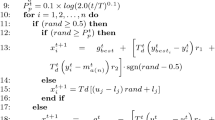Abstract
A novel binary particle swarm optimization for frequent item sets mining from high-dimensional dataset (BPSO-HD) was proposed, where two improvements were joined. Firstly, the dimensionality reduction of initial particles was designed to ensure the reasonable initial fitness, and then, the dynamically dimensionality cutting of dataset was built to decrease the search space. Based on four high-dimensional datasets, BPSO-HD was compared with Apriori to test its reliability, and was compared with the ordinary BPSO and quantum swarm evolutionary (QSE) to prove its advantages. The experiments show that the results given by BPSO-HD is reliable and better than the results generated by BPSO and QSE.
Similar content being viewed by others
References
HAN Jia-wei, PEI Jian, KAMBER M. Data mining: Concepts and techniques [M]. Third Edition. Elsevier, 2011: 243–262.
LUO Ke, WANG Li-li, TONG Xiao-jiao. Mining association rules in incomplete information systems [J]. Journal of Central South University, 2008, 15: 733–737.
ALATAS B, AKIN E. Rough particle swarm optimization and its applications in data mining [J]. Soft Computation, 2008, 12: 1205–1218.
YKHLEF M. A quantum swarm evolutionary algorithm for mining association rules in large databases [J]. Journal of King Saud University-Computer and Information Sciences, 2011, 23: 1–6.
ANKITA S, SHIKHA A, JITENDRA A, SANJEEV S. A review on application of particle swarm optimization in association rule mining [J]. Advances in Intelligent Systems and Computing, 2013, 199: 405–414.
XU Yang, ZENG Ming-ming, LIU Quan-hui, WANG Xiao-feng. A genetic algorithm based multilevel association rules mining for big datasets [J]. Mathematical Problems in Engineering, 2014: 867149.
BILAL A, ERHAN A. An efficient genetic algorithm for automated mining of both positive and negative quantitative association rules [J]. Soft Computation, 2006, 10: 230–237.
KUO R J, SHIH C W. Association rule mining through the ant colony system for national health insurance research database in Taiwan [J]. Computers and Mathematics with Applications, 2007, 54: 1303–1308.
KENNEDY J, EBERHART R C, LOZOWSKI A, CHOLEWO T J, ZURADA J M. Particle swarm optimization [C]//Proceedings of the IEEE International Conference on Neural Networks. Perth, Australia: IEEE press, 1995: 2147–2156.
KUO R J, CHAO C M, CHIU Y T. Application of particle swarm optimization to association rule mining [J]. Applied Soft Computing, 2011, 11: 326–336.
BOHANEC M, RAJKOVIC V. DEX: An expert system shell for decision support [J]. Sistemica, 1990, 1(1): 145–157.
BADAWY O M, SALLAM A A, HABIB M I. Quantitative association rule mining using a hybrid PSO/ACO algorithm (PSO/ACO-AR)[C]// JAMEL F. Proceedings of Arab Conference on Information Technology. Hammamet, Tunisia: CCIS Press, 2008: 1–9.
KABIR M M J, XU S X, KANG B H, ZHAO Z Y. Association rule mining for both frequent and infrequent items using particle swarm optimization algorithm [J]. International Journal on Computer Science and Engineering, 2014, 6(7): 221–231.
SALAM A, KHAYAL M S H. Mining top-k frequent patterns without minimum support threshold [J]. Knowledge Information System, 2012, 30: 57–86.
BANKS A, VINCENT J, ANYAKOHA C. A review of particle swarm optimization [J]. Nat Computation, 2007, 6: 467–484.
POLI R, KENNEDY J, BLACKWELL T. Particle swarm optimization an overview [J]. Swarm Intelligent, 2007, 1: 33–57.
KENNEDY J, EBERHART R C. A discrete binary version of the particle swarm algorithm [C]// JAMES M T. Proceedings of the Conference on Systems, Man, and Cybernetics. Florida, USA: IEEE Press, 1997: 4104–4108.
CLERC M. Discrete particle swarm optimization, illustrated by the traveling salesman problem [J]. Studies in Fuzziness & Soft Computing, 2004, 47(1): 219–239.
MIRJALILI S, LEWIS A. S-shaped versus V-shaped transfer functions for binary particle swarm optimization [J]. Swarm and Evolutionary Computation, 2013, 9: 1–14.
MIRJALILI S, MIRJALILI S M, YANG X S. Binary bat algorithm [J]. Neural Computation and Application, 2014, 25(3): 663–681.
Author information
Authors and Affiliations
Corresponding author
Rights and permissions
About this article
Cite this article
Zhang, Zj., Huang, J. & Wei, Y. Frequent item sets mining from high-dimensional dataset based on a novel binary particle swarm optimization. J. Cent. South Univ. 23, 1700–1708 (2016). https://doi.org/10.1007/s11771-016-3224-8
Received:
Accepted:
Published:
Issue Date:
DOI: https://doi.org/10.1007/s11771-016-3224-8




